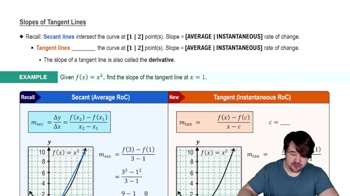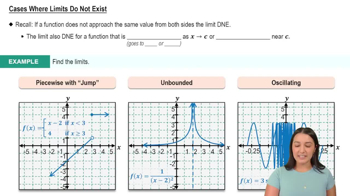A cost function of the form C(x) = 1/2x² reflects diminishing returns to scale. Find and graph the cost, average cost, and marginal cost functions. Interpret the graphs and explain the idea of diminishing returns.
Table of contents
- 0. Functions7h 54m
- Introduction to Functions16m
- Piecewise Functions10m
- Properties of Functions9m
- Common Functions1h 8m
- Transformations5m
- Combining Functions27m
- Exponent rules32m
- Exponential Functions28m
- Logarithmic Functions24m
- Properties of Logarithms36m
- Exponential & Logarithmic Equations35m
- Introduction to Trigonometric Functions38m
- Graphs of Trigonometric Functions44m
- Trigonometric Identities47m
- Inverse Trigonometric Functions48m
- 1. Limits and Continuity2h 2m
- 2. Intro to Derivatives1h 33m
- 3. Techniques of Differentiation3h 18m
- 4. Applications of Derivatives2h 38m
- 5. Graphical Applications of Derivatives6h 2m
- 6. Derivatives of Inverse, Exponential, & Logarithmic Functions2h 37m
- 7. Antiderivatives & Indefinite Integrals1h 26m
- 8. Definite Integrals4h 44m
- 9. Graphical Applications of Integrals2h 27m
- 10. Physics Applications of Integrals 3h 16m
- 11. Integrals of Inverse, Exponential, & Logarithmic Functions2h 31m
- 12. Techniques of Integration7h 41m
- 13. Intro to Differential Equations2h 55m
- 14. Sequences & Series5h 36m
- 15. Power Series2h 19m
- 16. Parametric Equations & Polar Coordinates7h 58m
2. Intro to Derivatives
Basic Graphing of the Derivative
Problem 3.5.61
Textbook Question
Slopes on the graph of the tangent function Graph y = tan x and its derivative together on (−π/2, π/2). Does the graph of the tangent function appear to have a smallest slope? A largest slope? Is the slope ever negative? Give reasons for your answers.
 Verified step by step guidance
Verified step by step guidance1
Graph the function \( y = \tan(x) \) on the interval \( (-\pi/2, \pi/2) \). Note that the tangent function has vertical asymptotes at \( x = -\pi/2 \) and \( x = \pi/2 \), and it is undefined at these points.
Find the derivative of \( y = \tan(x) \). The derivative is \( y' = \sec^2(x) \), which represents the slope of the tangent line to the graph of \( \tan(x) \) at any point where it is defined.
Analyze the behavior of \( y' = \sec^2(x) \) on the interval \( (-\pi/2, \pi/2) \). Since \( \sec^2(x) \) is always positive and increases without bound as \( x \) approaches \( \pm\pi/2 \), the slope of the tangent function becomes arbitrarily large near these points.
Determine whether the slope is ever negative. Since \( \sec^2(x) > 0 \) for all \( x \) in \( (-\pi/2, \pi/2) \), the slope of the tangent function is never negative on this interval.
Conclude that the graph of the tangent function does not have a smallest or largest slope because \( \sec^2(x) \) increases without bound as \( x \) approaches \( \pm\pi/2 \). The slope is always positive and becomes arbitrarily large near the vertical asymptotes.
 Verified video answer for a similar problem:
Verified video answer for a similar problem:This video solution was recommended by our tutors as helpful for the problem above
Video duration:
5mPlay a video:
Was this helpful?
Key Concepts
Here are the essential concepts you must grasp in order to answer the question correctly.
Tangent Function Behavior
The tangent function, defined as y = tan(x), has a periodic nature with vertical asymptotes at odd multiples of π/2. Within the interval (−π/2, π/2), the function increases from negative infinity to positive infinity, which affects the slopes of its tangent lines. Understanding this behavior is crucial for analyzing the slopes of the tangent function.
Recommended video:

Slopes of Tangent Lines
Derivative of the Tangent Function
The derivative of the tangent function, given by y' = sec²(x), indicates the slope of the tangent line at any point on the graph. Since sec²(x) is always positive for x in (−π/2, π/2), the slope of the tangent function is never negative in this interval. This concept is essential for determining the nature of slopes on the graph.
Recommended video:

Slopes of Tangent Lines
Limits and Asymptotic Behavior
As x approaches the vertical asymptotes of the tangent function at −π/2 and π/2, the function's values approach negative and positive infinity, respectively. This behavior implies that the slopes of the tangent function also approach infinity near these asymptotes. Understanding limits helps in identifying the largest and smallest slopes within the specified interval.
Recommended video:

Cases Where Limits Do Not Exist

 6:15m
6:15mWatch next
Master Graphing The Derivative with a bite sized video explanation from Patrick
Start learningRelated Videos
Related Practice
Textbook Question
